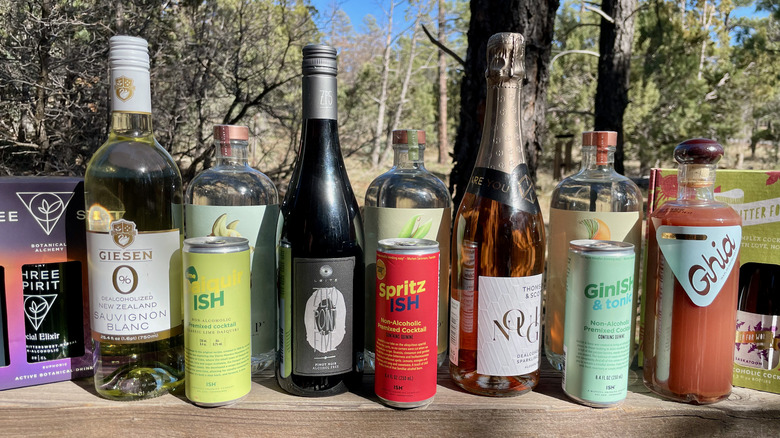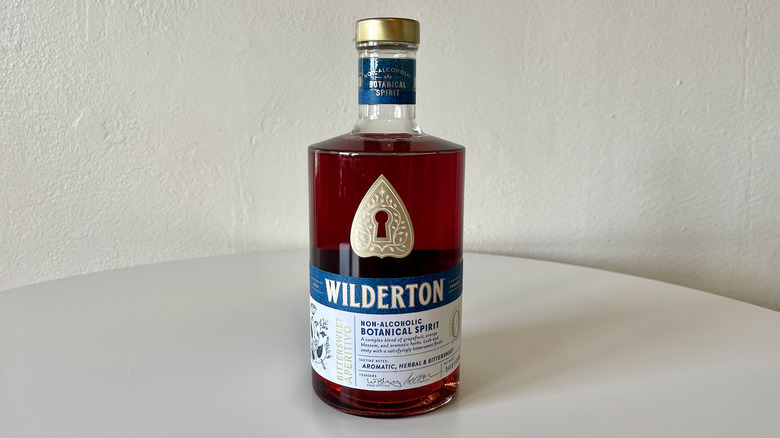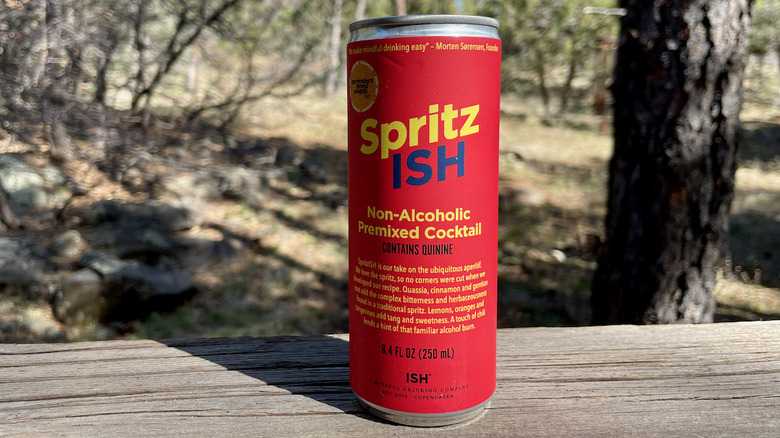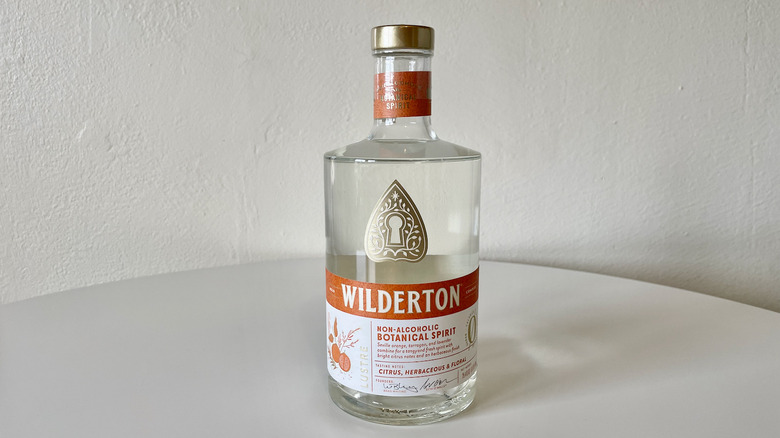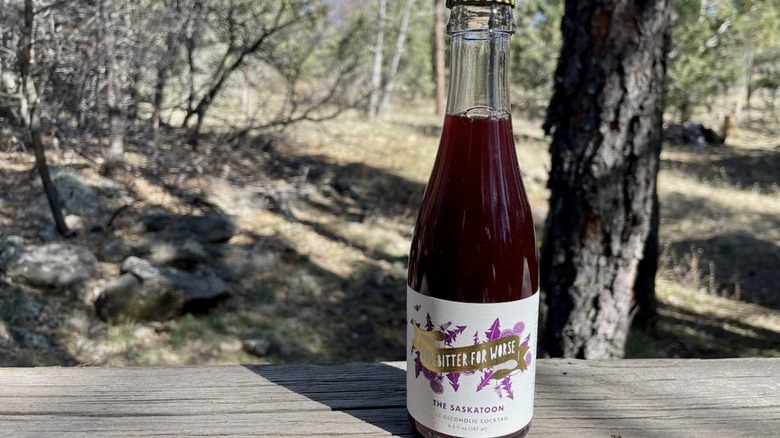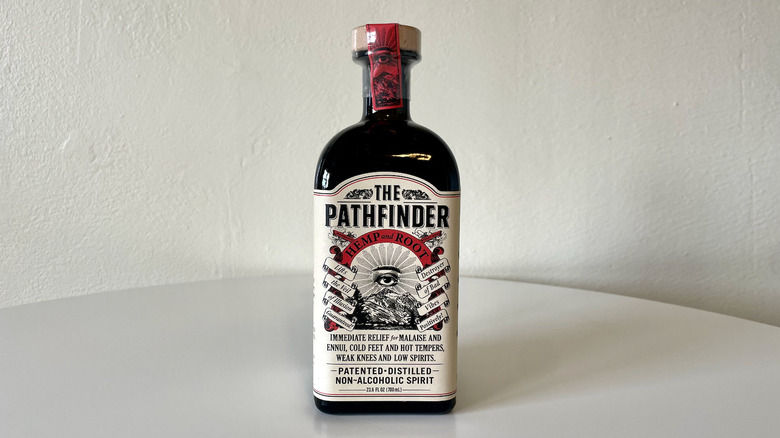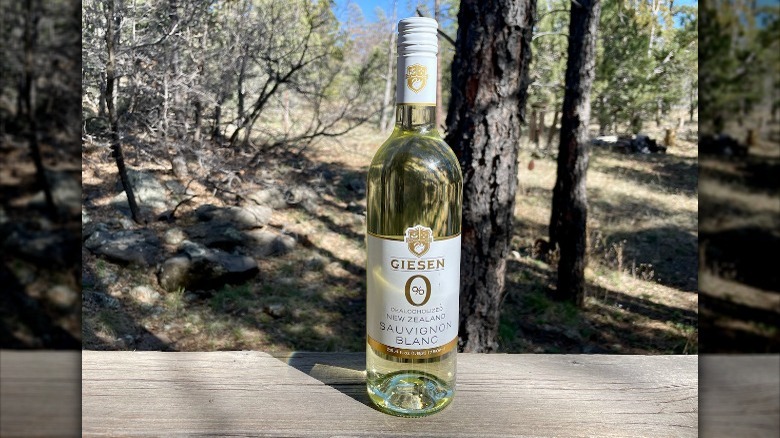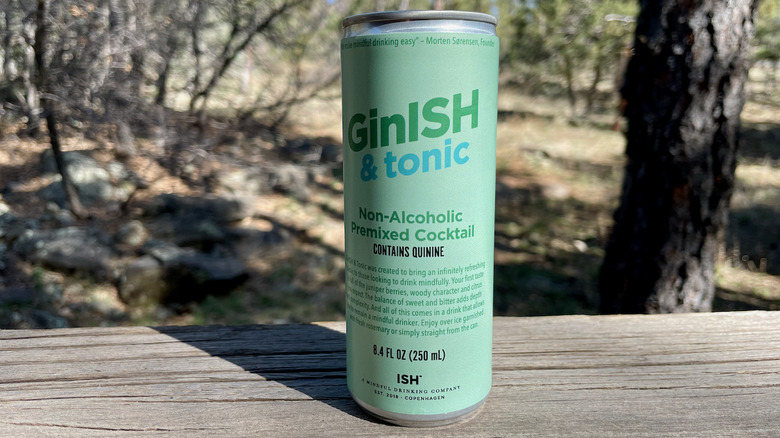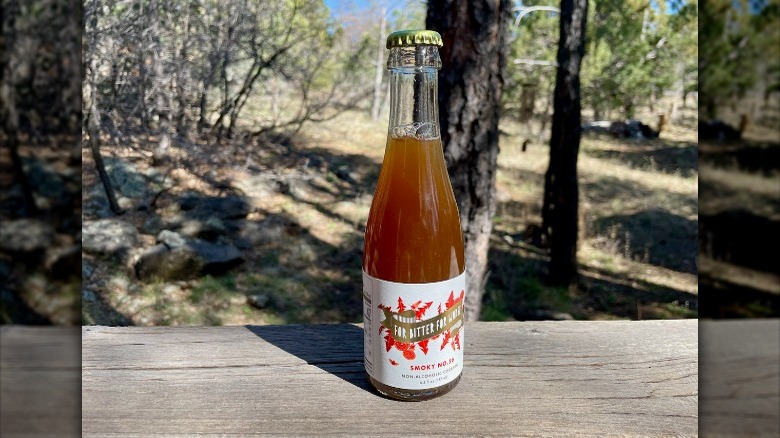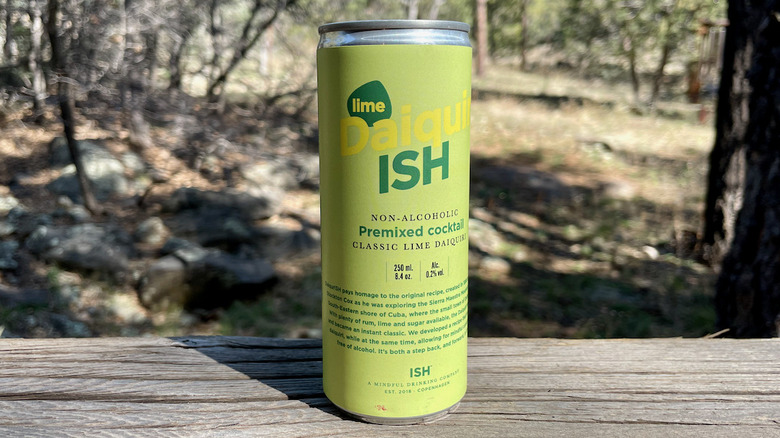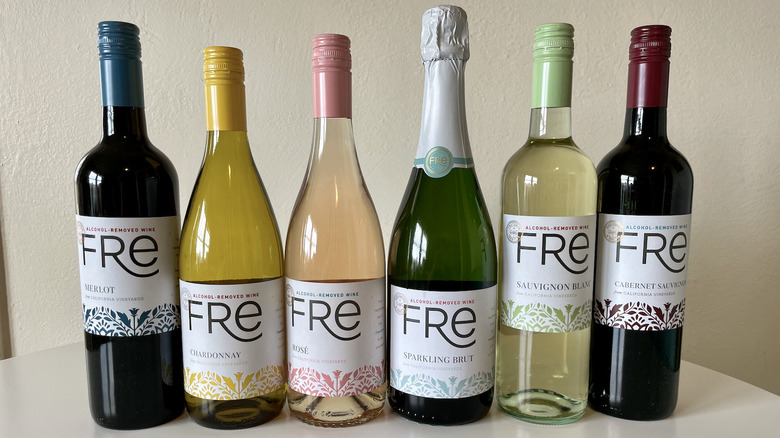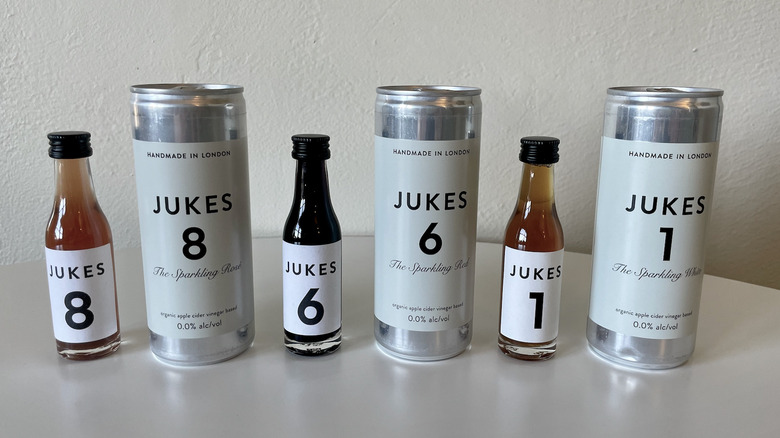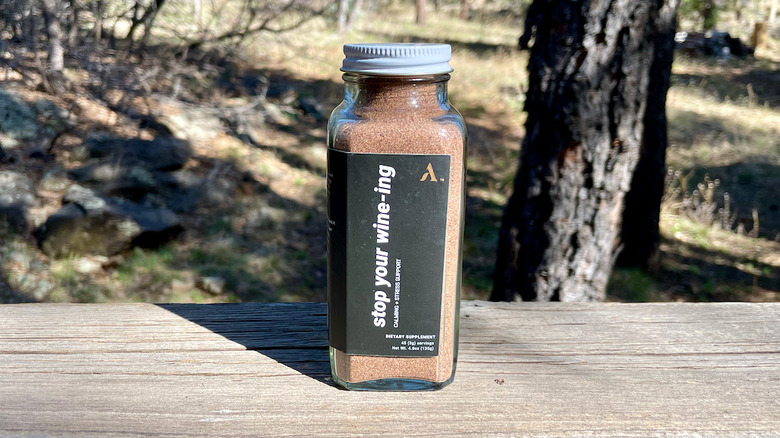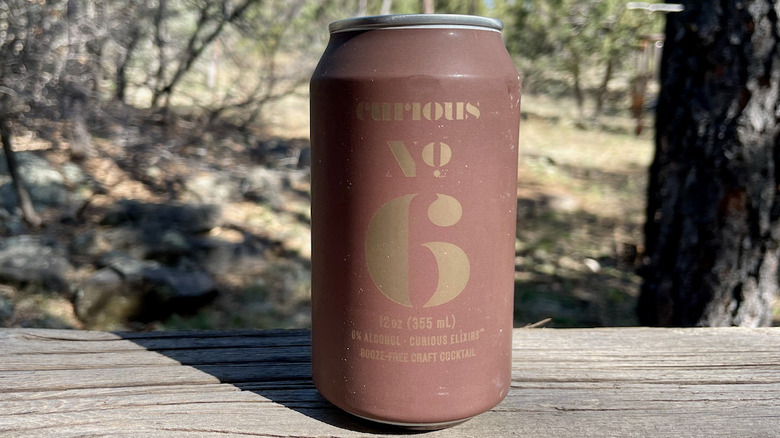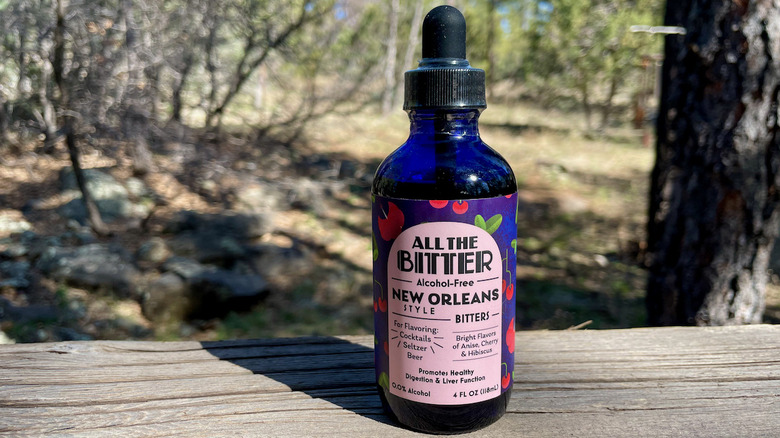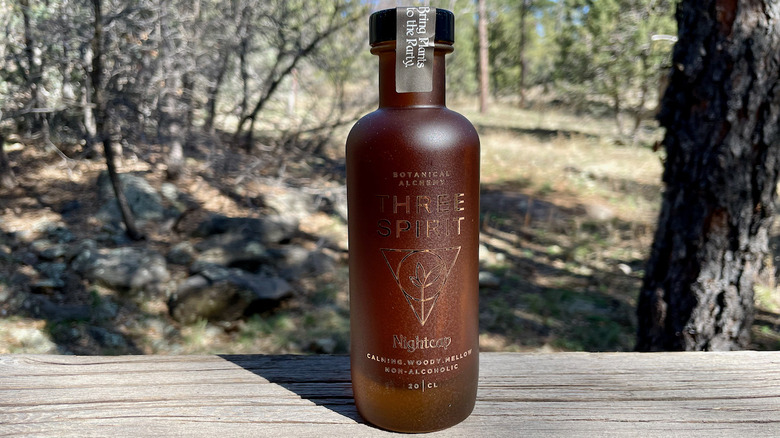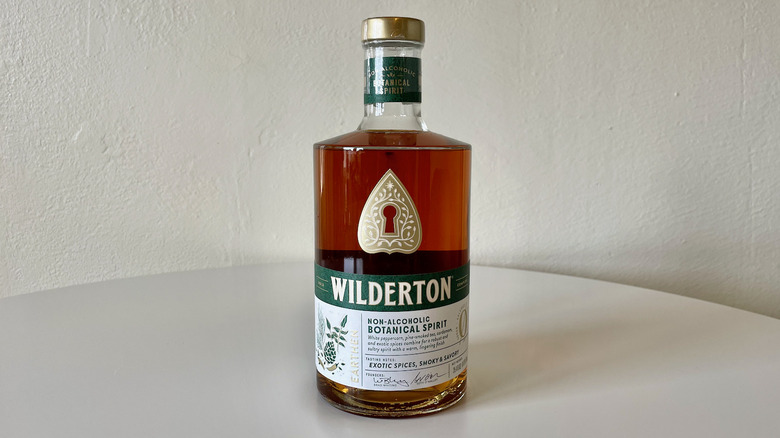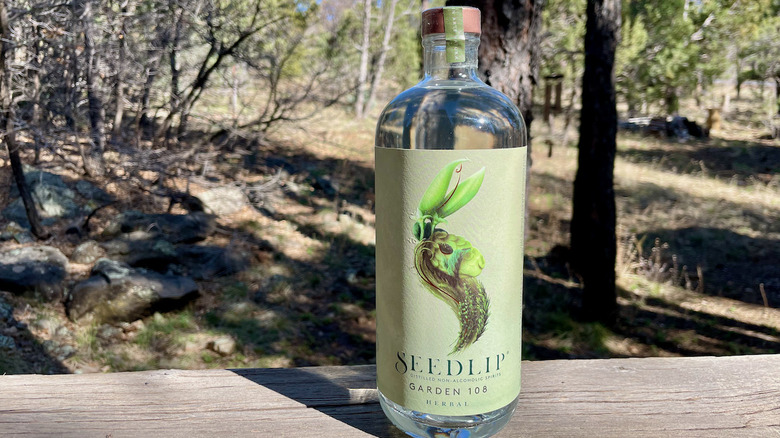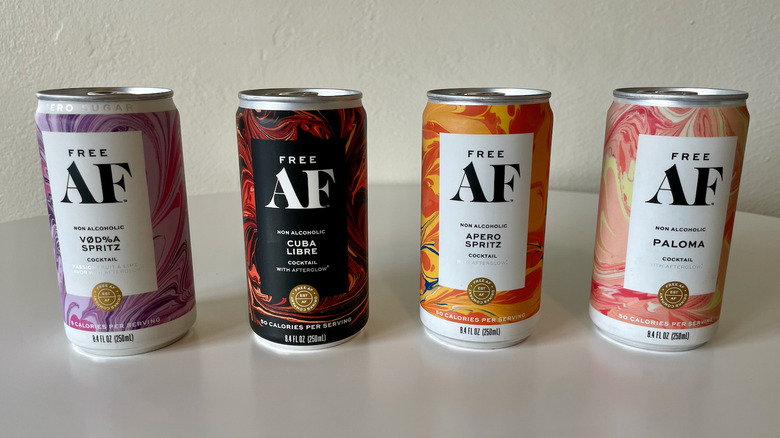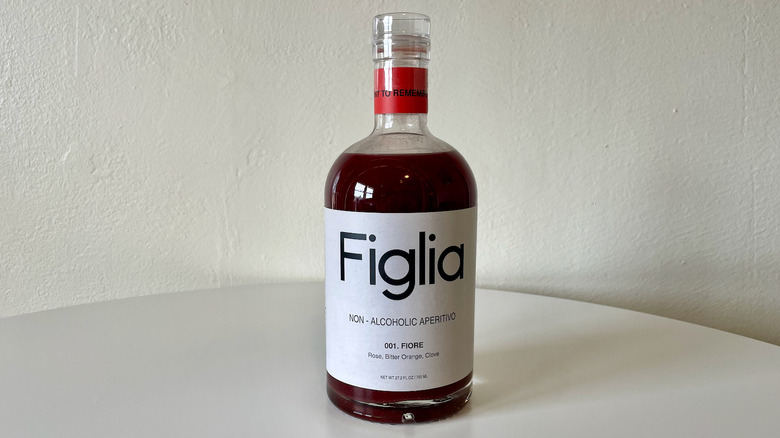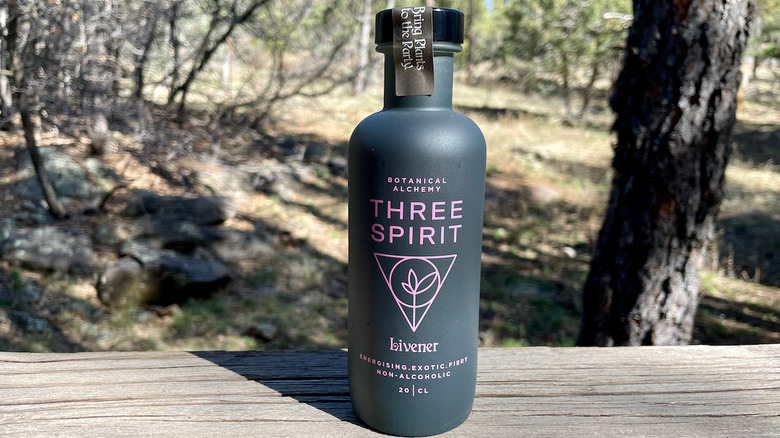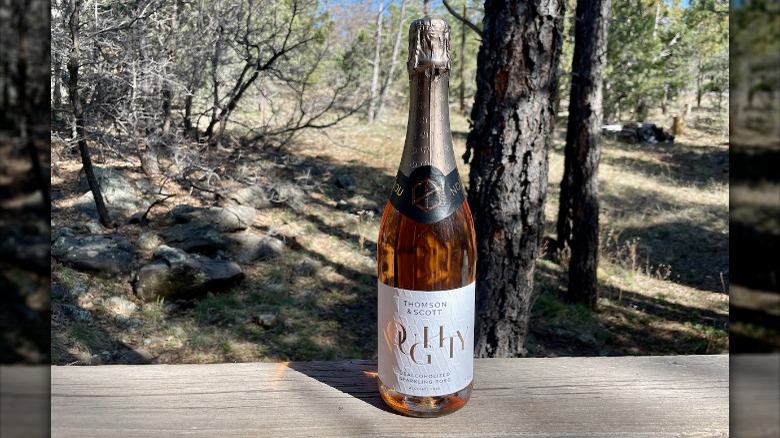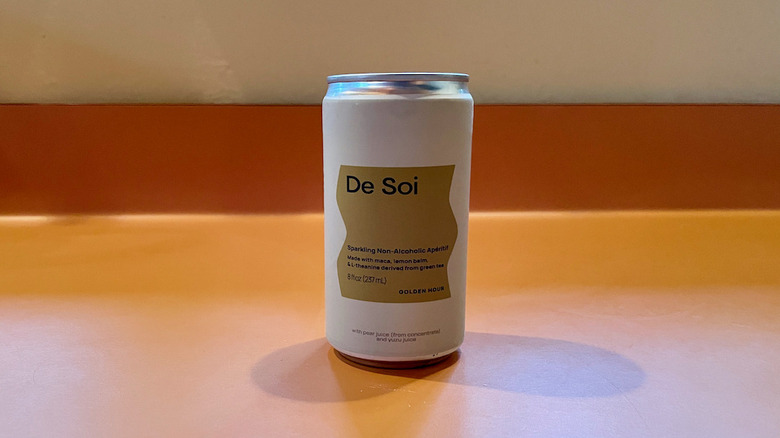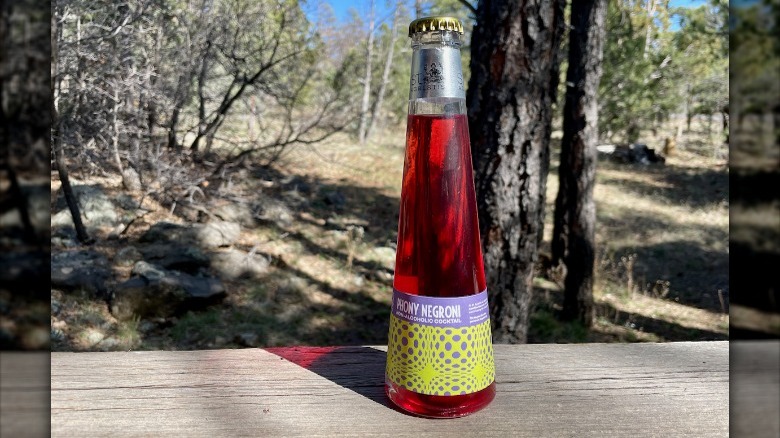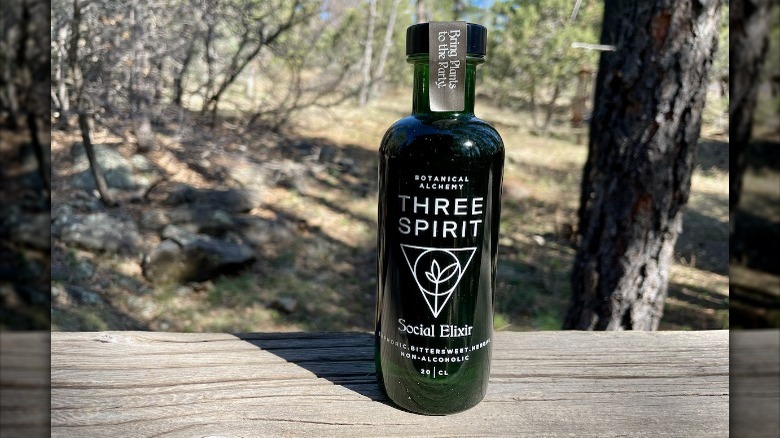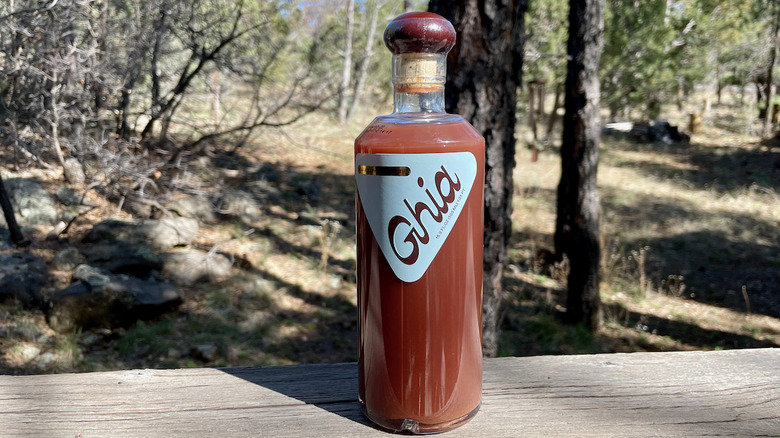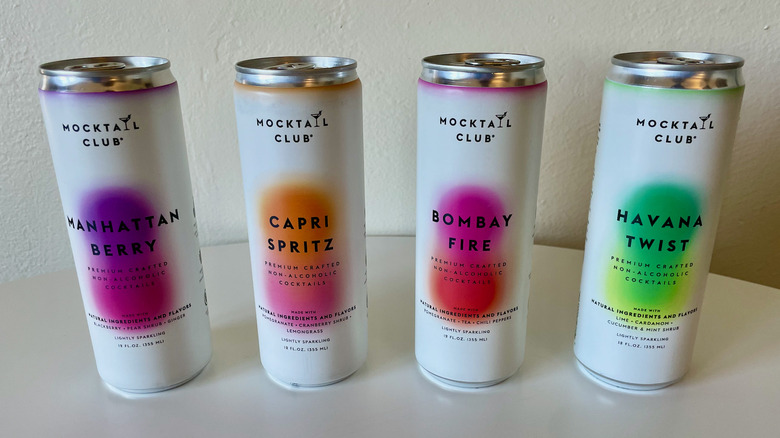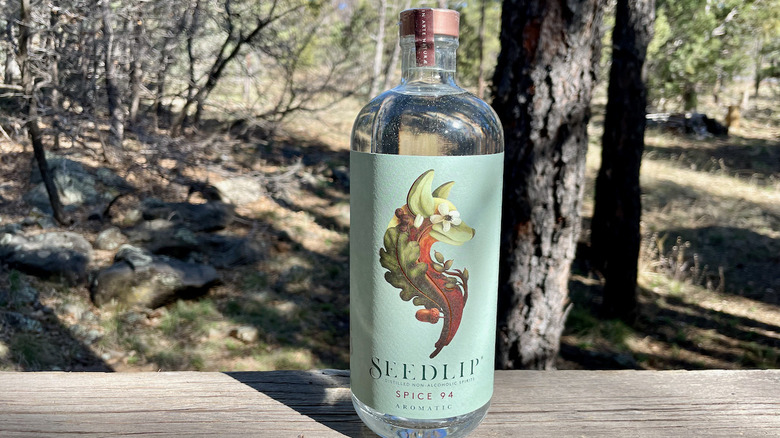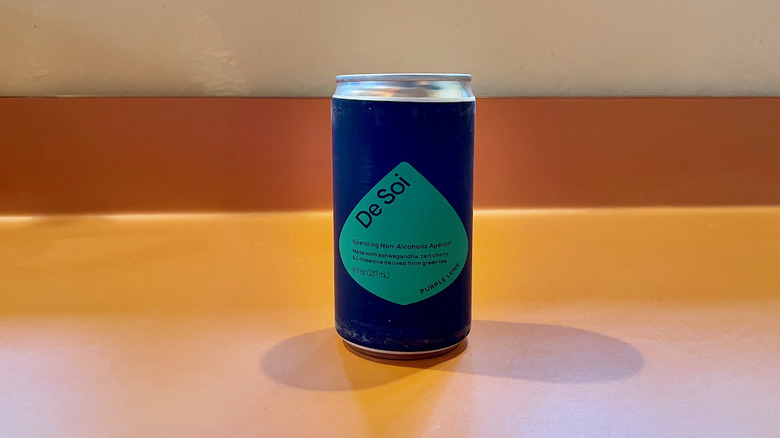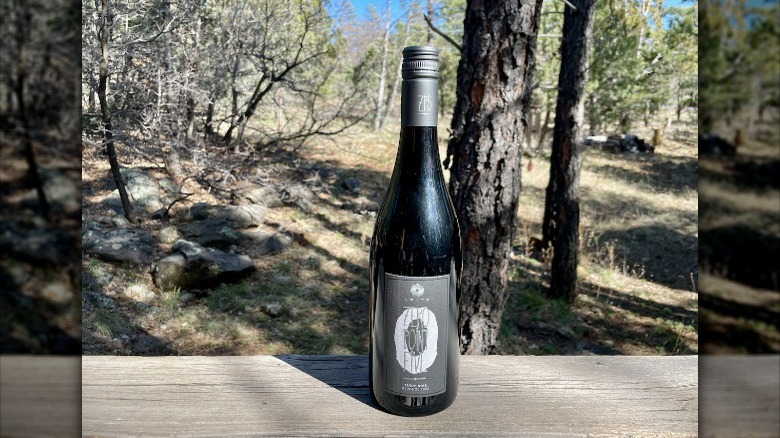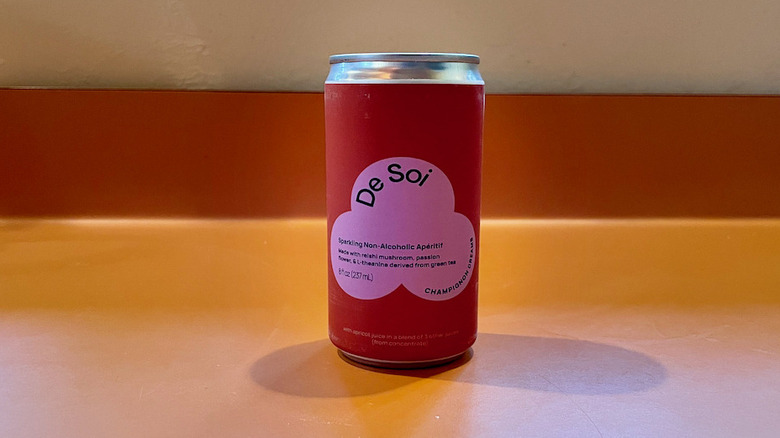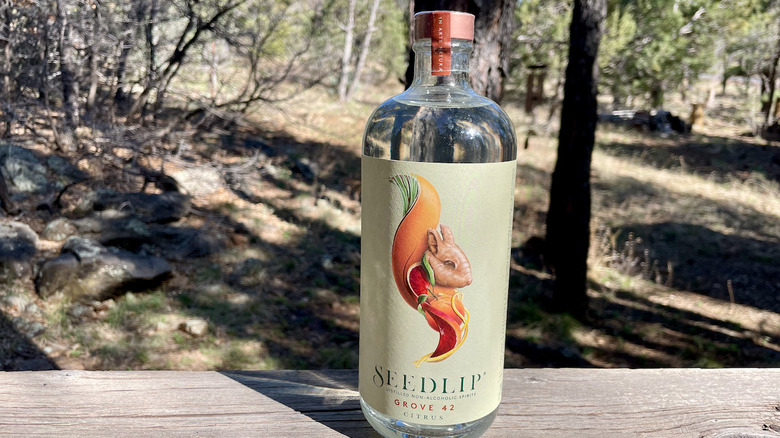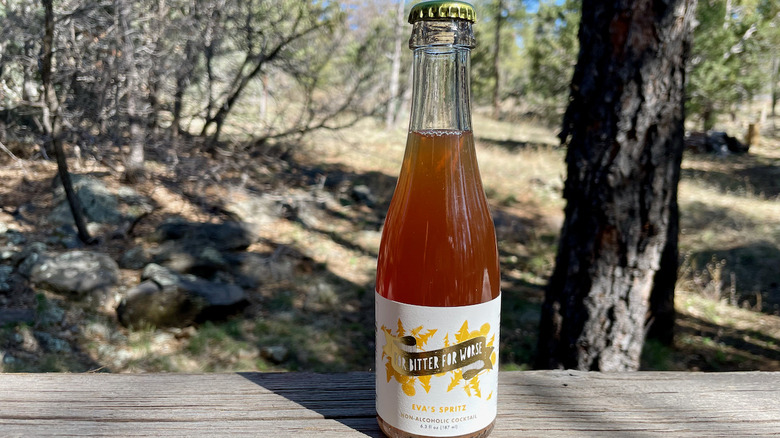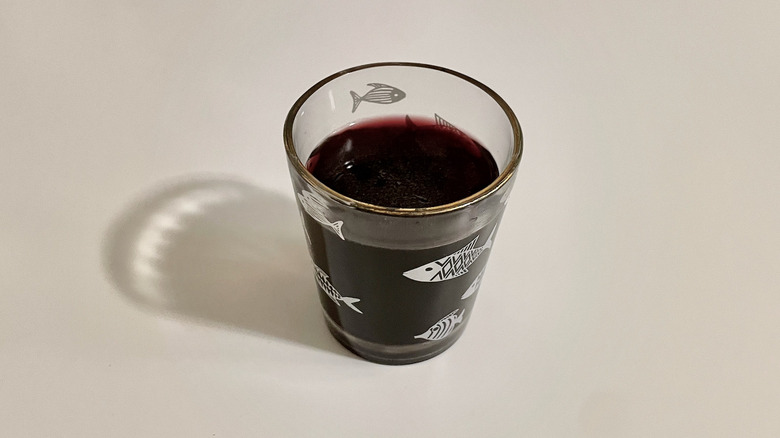32 Premium Alcohol Alternatives, Ranked
There's so much more to the world of alcohol alternatives than nonalcoholic beer or bright pink, saccharine Shirley Temples. In recent years, many different types of complex, carefully-made nonalcoholic options have entered the market. You can find beverages like dealcoholized wine that try to closely mimic specific alcoholic drinks, but many of the new alcohol alternatives try to replicate the depth of flavor of quality alcohol while also coming up with entirely new taste experiences.
High-quality alcohol alternatives aren't only for sober people or dry January, either. Tasting Table spoke to Ben Branson, the founder of nonalcoholic spirits company Seedlip, and Nick Bodkins, the co-founder of the NYC-based premium alcohol alternative boutique Boisson, and both told us that the majority of their customers are people who drink alcohol but are looking for options for when they don't feel like drinking (or drinking as much). Branson said he has noticed a real attitudinal shift in the years since he first introduced his product, noting that more people are accepting of the idea of nonalcoholic drinks than ever before.
These premium alcohol alternatives don't come cheap. Like the craft cocktails and spirits they're based on, these beverages are made carefully using high-quality ingredients, and that level of craftsmanship is reflected in their price. If you're willing to shell out for them, however, some of them do taste truly incredible. We tried a lot of them and ranked them so you know which ones are worth seeking out.
32. Wilderton Bittersweet Aperitivo
Wilderton Bittersweet Aperitivo is playing in a similar Campari/aperol territory as many other entries on this list. But it sets itself apart from its competitors with its unrelenting bitterness, which surpasses the bitterness of the amari it's clearly modeled after. The grapefruit and gentian smack you over the head with tannic flavors, making it far too strong to be consumed neat or on the rocks. Mixing it with tonic water or soda will tame the bitterness slightly, but no matter what we blended this drink with, it still made us pucker.
Although Bittersweet Aperitivo is made with a lot of sugar, it was hard to detect any sweetness over everything else going on in the recipe. While we can't say we found the experience to be entirely pleasant, we'll give props to Wilderton for taking big swings with its products — because Bittersweet Aperitivo isn't a wimpy alcohol-free spirit by any stretch of the imagination.
31. ISH Spritz
ISH is a Danish maker of alcohol alternatives with a wide range of products. It sells non-alcoholic wines, spirits, and canned cocktails — all of which previously had names that ended in -ISH (Château delISH, RumISH, etc.).
Spritz is a riff on an aperol spritz, that classic combination of Italian herbal liqueur and sparkling wine. While aperol lends a certain mild bitterness to a classic spritz, Spritz leans into the bitterness, with quinine and gentian hitting that flavor note quite hard. The drink has a citrus taste as well, but, once again, it's more of a bitter citrus peel flavor than sweet citrus juice. It lacks the balance of a traditional spritz because of its emphasis on the bitter side of the equation.
Another odd thing about Spritz is that it includes capsicum extract (aka hot chili pepper flavor), in an attempt to mimic the burn of alcohol. An aperol spritz is a relatively low-alcohol beverage to begin with, so we're not looking for a burn from a spritz. The spiciness in this drink was pretty strange, and, combined with the bitterness, it made our mouth feel weird and gave us heartburn.
30. Wilderton Lustre
Given it's completely transparent and flavored with citrus and herbs, we expected Wilderton Lustre to taste like a gin analog — but it's doing its own thing. The smell hits you immediately with bitter orange as well as savory notes from botanicals (including lemongrass and lavender). It doesn't seem like it's meant to be sipped on its own, though, as on the rocks was almost painfully sharp, delivering a peppery sensation that numbed our tongue.
Tonic water helped mellow it out a bit, but it was still really intense. The bitter orange remained incredibly astringent, and the burning sensation from the other botanicals didn't diminish, either. While Lustre did a good job emulating the intensity of an alcoholic spirit, we didn't enjoy it that much (even when watered down with quite a bit of tonic). Frankly, the flavors just didn't combine enjoyably. We could see it being useful in small amounts as a cocktail component — where it could be balanced with several other ingredients — but it was too overpowering to be the star of a highball.
29. For Bitter For Worse The Saskatoon
For Bitter For Worse is a company that makes three different bottled cocktails. The Saskatoon was the one we liked least out of the three, though it was quite interesting. The description on the website name-checks negronis, but, to our palate, the Saskatoon didn't seem like it was trying too hard to replicate any existing beverage. We enjoyed the originality, but, taste-wise, The Saskatoon didn't resonate with us.
The Saskatoon is made with saskatoon berries, a native North American fruit that looks like a blueberry but tastes kind of nutty. The drink also contains citrus, grape juice concentrate, a variety of herbs and spices, and Douglas fir needles.
The smell of The Saskatoon promises berry flavors, but the taste was surprisingly bland. It was neither sweet nor tart, and the most prominent flavor note was a kind of tannic bitterness. It felt quite dry in the mouth and finished with a black pepper kick. Without sweetness to back them up, the bitter and spicy flavors felt out of place.
28. The Pathfinder Hemp and Root
The Pathfinder's marketing includes a lot of cutesy references to old-timey snake oil salesmen and medicine shows. The bottle includes lighthearted (and unsupported) claims, like a promise to provide "immediate relief for malaise and ennui." Though the product starts as a distillate of fermented hemp, as far as we can tell? It contains no THC or CBD (we certainly didn't get any kind of buzz from the 2 ounces we drank for this test).
We did detect a bit of a cannabis aroma in the glass, but Hemp and Root's flavor wasn't particularly hempy. Instead, the other botanicals came to the fore. We were particularly walloped by the intense bitterness from the wormwood and piney notes from the Douglas fir extract. The bitter flavor combined with the drink's syrupy texture (sugar is the second listed ingredient) made Hemp and Root taste quite a bit like fernet. The astringency was too much for us, but if you're a big Fernet-Branca fan, this would be right up your alley.
27. Giesen sauvignon blanc
According to a Tasting Table interview with Nick Bodkins, the co-founder of zero-alcohol drink store Boisson, dealcoholized wine is made by putting regular wine in a vacuum. In a vacuum, wine boils at room temperature, so the alcohol in the wine boils away. The dealcoholized sauvignon blanc from the New Zealand winemaker uses a special process that first separates the wine's aroma before the alcohol is removed. The aromatic compounds are then added back to the wine, along with a little bit of grape juice.
This sauvignon blanc wasn't our favorite non-alcoholic wine. It did taste like white wine, but it reminded us of a budget bottle. It also had the off-taste we associate with leaving an open bottle of white wine in the fridge for too long. The wine was exceptionally dry, but other than that it didn't have a very strong flavor. We could taste a mild hint of grape juice, but we wanted more fruit from this bottle.
26. ISH G&T
The second offering from ISH was definitely an improvement over Spritz. It contains quinine, but not enough to make it overwhelmingly bitter. Its smell reminded us of acetone, but not in an unpleasant way.
Flavor-wise, at first sip, it mostly tasted like tonic water but less sweet. The second flavor we noticed was citrus, particularly lime juice (though no actual lime juice is mentioned among its ingredients). As the drink warmed up slightly, we were able to pick up more of the herbal notes of gin, most prominently the evergreen taste of juniper.
Overall, G&T was a light, refreshing summer sipper. However, there was one aspect of the drink we didn't enjoy: Like ISH's Spritz, it has capsicum extract in it. We like spicy food, but something about the capsicum in this context didn't work for us. The burn only intensified over time, and it was a struggle to finish the whole can.
25. For Bitter For Worse Smokey No. 56
For Bitter For Worse Smokey No. 56 is marketed as a good option for people who like whiskey. It's made with lapsang souchong tea, a type of smoked black tea. Presumably, the smokiness of the tea is a nod towards whiskey, which is usually aged in charred wooden barrels. Maple syrup is another main flavor component of this drink. The maple could help replicate the caramel-like sweetness of some whiskeys.
Smokey No. 56 doesn't taste anything like whiskey. That's not necessarily a bad thing, but if that's what you're looking for, you might be disappointed. The most predominant flavor is the smoke from the lapsang souchong. Behind that, maple syrup, fig concentrate, and apple cider vinegar make their presences known. The vinegar gives this beverage a little bit of a shrub vibe. In the aftertaste, you get a little bit of herbal bitterness and spice. It tastes like there might be black pepper or cayenne in this, though the ingredients label just says "spices."
The closest thing we can compare this drink to is mulled cider, but it's unlike anything we've ever tasted. It's not shy about bringing bold flavors, but we're not sure if all the competing tastes harmonize well.
24. ISH Lime Daiquiri
The final canned cocktail we tried from ISH was Lime Daiquiri. This drink is intended to mimic the classic original daiquiri, a simple blend of rum, lime juice, and simple syrup. Of all the ISH drinks, this one was the closest to its inspiration, and also our favorite.
Mercifully, Lime Daiquiri did not contain any capsaicin. Instead, it actually had rum flavoring in it. Drinking something non-alcoholic that tasted like rum was kind of odd, but not entirely unpleasant. To be clear, it tasted more like the rum extract you would find in rum raisin ice cream than like real rum, but it did add to the daiquiri vibes.
There's no lime juice in this one, but there is lime flavoring. You get some floral lime peel flavor, which is nice. Overall, it tastes like a thick, syrupy limeade with a hint of rum. ISH recommends splitting one can into two cocktails, which seems like a good idea. We found this tasted better when poured over ice, as the cold temperatures and dilution helped temper the sweetness.
23. Fre Alcohol-Removed Wine
We got a chance to sample several different varieties of Fre Alcohol-Removed Wine, including a pair of reds, a pair of whites, a rosé, and a Champagne-like sparkling brut. Of the ones we tried, the sparkling brut was our favorite. While no one would confuse it for Dom Perignon, it closely mimicked the taste of a mid-level bottle of prosecco, cava, or Champagne.
The sparkling brut had a pleasantly sweet flavor, a good level of carbonation, and enough acidity and sharpness to be reminiscent of conventional wine. It did seem slightly fruitier than alcoholic Champagne would be and almost tasted like Champagne mixed with Martinelli's sparkling cider. The other Fre bottles were also tasty, but they weren't quite as successful as the sparkling brut.
The company says it uses a spinning cone to filter the alcohol out of the wine — though we suspect this filtration system also deprives the wine of flavor. After all, Fre products include grape concentrate and other flavoring in addition to the dealcoholized wine. Without bubbles to smooth things over, we could detect more of the grape juice character in the non-sparkling wines. They also tended to have a vinegar-like acidity that read less like wine and more like kombucha. All in all, they weren't bad, but a couple of the other brands of dealcoholized wine tasted more convincing and luxurious.
22. Jukes Cordialities
We tried six products from Jukes Cordialities: Jukes 1, 6, and 8, in both concentrated and canned, sparkling form. Jukes 1 is white, 6 is red, and 8 is rosé. Though Jukes' beverages are meant to be a substitute for wine, they're not trying to taste exactly the same as vino. Rather, they're more like shrubs (sweetened vinegar-based drinks) that evoke some of the nuances of wine's flavor.
The small bottles of concentrate are supposed to be diluted with water (each has enough to make two glasses), while the cans are pre-mixed with seltzer and ready to drink. We preferred the concentrates, as they allowed us to customize our dilution levels. As you might expect from drinks made with vinegar, all the Jukes flavors we tried were quite sour and acidic. While we found the level of acidity a bit overbearing, people with a high tolerance for sourness might think differently. With the concentrates, we could add extra water and even a bit of sweetener to mellow out the acid. But there was no tempering the sharpness of the canned drinks (and the fact that carbonated water is already slightly sour by itself didn't help).
None of the products tasted much like wine, but each flavor offered a different experience. The red tasted more berry-forward, the white had an herbaceous, vegetal quality, and the rosé tasted like melon.
21. Apothékary Stop Your Wine-ing
This powder with a punny name is marketed as an alcohol-free way to unwind. Its manufacturer says that it's made with ingredients that will relax you and ease your anxiety. Unlike most of the products on this list, Stop Your Wine-ing comes with some health warnings: The description on the website hints that the product may have a sedative effect in large doses, and it's not safe to drink if you're pregnant. Its active ingredients include motherwort, açaí, aronia berries, and jujube dates.
The ingredients in this may pack a kick if you drink a lot of it, but we didn't notice any tiredness from consuming the recommended dose. Apothékary recommends mixing it with warm milk, warm water, or fruit juice if you're looking for something more wine-like in flavor. The powder has a slightly gritty texture and doesn't dissolve super easily, so we would recommend using some kind of hot liquid if you don't want a powdery beverage.
When drunk with hot water, Stop Your Wine-ing seemed a lot more like tea than wine. It had some fruity notes in the aroma, but it also smelled like matcha. The flavor was even more tea-like than the smell, with an earthiness that reminded us of wood. It had a little bit of tartness in the aftertaste. It became progressively grittier as we approached the bottom of our cup. It was overall pleasant and relaxing but didn't scratch the same itch as wine.
20. Curious No. 6
Curious Elixirs makes a range of alcohol-free pre-mixed cocktails from No. 1 to No. 7. The drinks are made with adaptogenic ingredients that the company claims can aid in relaxation. The brand's No. 6 blend is clearly a tiki-inspired concoction. It's based on a Painkiller, which is a tiki drink made with pineapple juice, orange juice, cream of coconut, rum, and nutmeg. The No. 6 is made with all those ingredients (minus the rum, of course), plus oat milk, lemon balm, aloe, and neroli. Because of the last two ingredients, No. 6 is not safe for pregnant or lactating people.
With all of those strong-tasting ingredients, you'd expect Curious No. 6 to be a pretty intense flavor experience, but it's surprisingly muted. The creaminess from the oat milk and coconut cream may counteract the sharpness of the pineapple and citrus juice. No. 6 is tasty and well-balanced, but it does feel like it's missing something. Perhaps this is sacrilegious in an article about alcohol alternatives, but rum would really wake it up.
19. All the Bitter New Orleans Style Bitters
You wouldn't necessarily think about it since they're used in such small quantities in drinks, but traditional bitters are actually quite alcoholic. The two most popular kinds of bitters, Angostura and Peychaud's, are 89.4 and 70 proof, respectively. That means that if you are committed to mixing 100% alcohol-free drinks, you need alternative bitters with no booze.
This is where All the Bitter comes in. The company makes three different types of nonalcoholic bitters. The one we sampled, New Orleans Style, seems to be modeled after Peychaud's, which was first sold in New Orleans. Like Peychaud's, its main flavor components are cherry and anise.
You get a lot of cherry in its aroma, but less in the flavor. The taste is anise-forward, with a savory complexity that reminded us of five-spice-scented Chinese food. There is a hint of bitterness in the aftertaste. All the Bitter is less strong than most alcoholic bitters we've tried. We tasted it in some plain seltzer and ended up putting about a dozen drops in our glass to get the full flavor. If we tried the same thing with Peychaud's, it would have been hard to drink the results.
18. Three Spirit Nightcap
Three Spirit makes beverages with ingredients that the company describes as nootropic and adaptogenic. The drinks are supposed to enhance your mood, and each one is designed to affect you differently. Nightcap is supposed to relax you before bed. We didn't really notice any effect on our moods from any of Three Spirit's products, so we will evaluate them solely on flavor.
Nightcap is the only Three Spirit product that the company recommends drinking by itself on the rocks. It has valerian in it, which, according to WebMD, has sedative properties. The aroma of hops dominated this drink's smell. The first thing you notice in the flavor is dark maple syrup. It's also pretty spicy, which could be from the ginger, black pepper, and Sichuan peppercorns in the recipe. There is some bitterness, but it's not overwhelming.
Other than maple syrup and spice, the most dominant flavor in this is a kind of earthy woodiness. It's quite thick and syrupy, so you might want to dilute it a bit. It tasted good, but we thought other Three Spirit drinks were better and more balanced.
17. Wilderton Earthen
Earthen was our favorite offering from Wilderton. Like the company's other non-alcoholic spirits, it's obviously meant to be used in cocktails rather than quaffed straight. The recipe's white peppercorn is nose-clearingly strong on its own. However, taking Wilderton's suggestion by mixing Earthen with ginger ale made for a tasty beverage.
The white peppercorn remained the dominant flavor, but dilution allowed us to pick up some smokiness from the tea along with floral notes from the cardamom. The savory flavors of Earthen, in turn, tamped down the sweetness of the ginger ale and turned it into a cocktail that tasted distinctly adult.
Wilderton Earthen and ginger ale did a wonderful job of evoking the experience of drinking soda mixed with real spirits. Although it didn't taste exactly the same, the pepper gave the drink a sharpness that was quite similar to ethanol burn — and made us feel like we were sipping a whiskey ginger at a fancy cocktail bar.
16. Seedlip Garden 108
Unlike many spirit alternatives, which are made by infusing ingredients in liquid, Seedlip is distilled, just like a normal spirit. Except, with Seedlip, distillation is used to remove alcohol rather than concentrate it. As founder Ben Branson explained in an interview with Tasting Table, Seedlip is made by soaking botanicals in alcohol to extract their flavor. Then, the infusions are distilled to separate the flavor compounds from the alcohol. Each botanical is extracted individually, and then the distillates are blended and diluted with water to make the finished beverage.
Seedlip Garden 108's dominant flavor is sweet pea. On its own, it smells like a cleaning solvent. The flavor is very intense. It tastes like peas without any sweetness, which is quite a strange experience. There's also a strong note of hay, which adds to the garden flavor. It's quite evocative of the outdoors, but not great on its own.
Mixed with tonic, it becomes a different experience entirely. The sugar in the tonic adds the sweetness missing from the pea flavor, and the combination of Garden 108 and tonic creates a cucumber-like aroma and taste. It's reminiscent of a gin and tonic made with an eccentric boutique gin. The flavor of the Seedlip is rather delicate, so you have to use more than you would use in a regular gin and tonic to get the full flavor experience.
15. Free AF canned cocktails
When alcohol-free beverage makers try to imitate the burn of real alcohol, it often doesn't go well. We usually prefer when manufacturers focus on flavor rather than attempting to recreate that aspect of the alcohol experience. However, Free AF does a better job than most with the proprietary Afterglow flavoring it puts in its canned mocktails.
Now, we're not entirely sure what Afterglow is ... but it made our mouths tingle like real booze. Beyond that, the flavor of these canned beverages was pretty good. Our least favorite was the Vød%a Spritz, since it seemed strange to try and replicate a vodka soda (which is basically a flavor-free drink even with alcohol). The other three flavors we tried — Apero Spritz, Cuba Libre, and Paloma — were all tasty, though they could have been sweeter to our palates.
This might be because Free AF is trying to limit calorie counts. The 8.4-ounce can of Cuba Libre clocked in at only 50 calories while trying to mimic the flavor of a rum and Coke — but the drink could have used more calories and sugar. Still, we'd bet many people will be happy to sacrifice a bit of flavor in order to be a bit healthier by drinking less sugar, so we can't ding the company too much for the lack of sweetness.
14. Figlia Fiore
Don't be fooled by the name. As the bottle's label explains, Figlia has nothing to do with fig — it's simply the Italian word for daughter. Figs or no figs, this non-alcoholic aperitivo is still fruity and pours sweet and thick. The second listed ingredient is white grape juice concentrate, which we suspect is what gives the drink its body and sweetness.
Its flavor starts with straightforward notes of sweet grape juice and citrusy acidity, though more complex tastes soon emerge. There's a lot of floral character in Figlia Fiore from ingredients like elderflower flavor, rose extract, rosemary extract, chamomile extract, and lemon balm extract. Ginseng root and orange rind add a hint of bitterness to temper the sugar in the fruit juice. No one ingredient takes precedence over another; there are so many components in the mix that they all blend together harmoniously.
Although we didn't notice much of a burn on the tongue while sipping Figlia, it did leave us with a burning sensation in the throat on the way down. While some people might enjoy this — as it's somewhat like the fiery taste of alcohol — we didn't love it (it felt like heartburn). That complaint aside, Figlia tasted great. The company also makes a sparkling, canned version of Fiore, which we suspect would also be quite tasty.
13. Three Spirit Livener
Livener, as the name suggests, is supposed to perk you up. Three Spirit says it's a good drink for parties. It contains some caffeine from guayusa, also known as Amazonian holly, so it should actually give you a little bit of energy. The company claims that the drink's schisandra berries should also contribute a mild euphoric effect. We drank this right before bed and fell asleep normally, but, to be fair, we didn't drink very much.
Three Spirit recommends that you mix this with tonic, and we agree. On its own, Livener is incredibly intense. It has notes of red fruits like berries and plums. There's a little bit of acid to balance the sweetness and a fair amount of heat from a dash of pepper. We could detect a little bit of vinegar as well.
Mixed with a tonic, it turned into a yummy spritz-like beverage. The acid from the Livener neutralizes the tonic's bitterness, leaving you with something sweet, fruity, and delicious. The one thing we weren't huge fans of was the amount of heat. It became less intense once we mixed the Livener with tonic, but it still burned on the way down in a way we didn't love.
12. Thomson & Scott Noughty
We found this Noughty sparkling rosé to be much more successful than the Giesen sauvignon blanc. It delivered a much more intense and nuanced flavor than that zero-alcohol white did.
The Noughty had a nice amount of carbonation and a pleasant level of sweetness: Enough to taste fruity, but not enough to be syrupy. The sweetness was accompanied by hints of tartness and dryness. We also detected a distinct mineral flavor that reminded us of a high-quality traditional (that is, alcoholic) rosé. It's made from organic tempranillo grapes. One benefit of this nonalcoholic rosé is that it has significantly less sugar than a rosé with alcohol.
This wine is delicious, but you can definitely tell it's nonalcoholic. Without the burn we would expect from booze, it reminded us a little bit of Martinelli's sparkling cider or sparkling grape juice. However, this didn't diminish our enjoyment of it too much.
11. De Soi Golden Hour
De Soi is a line of carbonated nonalcoholic aperitifs from Katy Perry and Morgan McLachlan. As with many of the drinks we tested, De Soi is made with supposedly nootropic ingredients that are intended to affect your brain and mood in various ways. Also, like other drinks on this list, the nootropics didn't seem to do anything to us, though your results may vary.
Golden Hour is the thickest and most full-bodied drink in De Soi's lineup, probably because it's made with pear juice concentrate. Other than pear, the thing you taste the most in it is tea. It contains several tea extracts, including earl gray, chamomile, and green tea. It's one of the sweetest drinks we tried for this test, though that doesn't mean it's not complex. The blend of tea and herbal extracts gave this a nuanced flavor. However, we would have liked Golden Hour more if it had a little more acidity to counter the sweetness.
10. St. Agrestis Phony Negroni
As its name suggests, the St. Agrestis Phony Negroni is supposed to replicate the classic mix of gin, Campari, and vermouth without alcohol. Unlike many of the manufacturers of alcohol alternatives, St. Agrestis primarily sells alcoholic beverages. The company offers alcoholic pre-mixed negronis and a variety of bitter amaros.
The manufacturer's negroni expertise is evident in the flavor of the Phony Negroni. It strikes the right balance between hitting the flavor notes you expect from its namesake drink and being a tasty beverage in its own right. It lacks the intense bitterness and sharp gin bite of a traditional negroni, instead of balancing its bitter herbal elements with sweetness. It's also carbonated, unlike a classic negroni.
Because of the sweetness and carbonation, it tasted more like an aperol spritz than a negroni, which we didn't mind at all. The Phony Negroni had notes of fresh citrus, quinine-like bitterness, lemon-lime soda, and maraschino cherry. It was delightful and refreshing and would be a great summer day beverage.
9. Three Spirit Social Elixir
Social Elixir is supposed to make you feel happy and ready to socialize, with the cacao in Social Elixir intended to lift your mood. Lion's mane mushroom is added for its claimed nootropic, focus-enhancing benefits. Intriguingly, Social Elixir also contains damiana, which Three Spirit says is a natural aphrodisiac.
This beverage pairs well with ginger ale. On its own, it has a very strong but not unpleasant flavor. However, it's so thick and syrupy that it's much better when thinned out. Social Elixir has an intense dried fruit flavor. It tastes and smells like a blend of dates, prunes, and raisins. You get a little bit of herbal bitterness, but not much.
After we diluted Social Elixir with ginger ale, it became significantly less raisiny in flavor. It turned into some kind of mixed-fruit soda, almost like an artisanal Dr. Pepper. We also noticed a vanilla-like flavor. It was quite tasty.
8. Ghia
Ghia is an alcohol-free aperitif. Of all the beverages we tried for this test, it tasted the most like an actual amaro or herbal liqueur. It contains grape juice concentrate for sweetness, gentian for bitterness, fig, elderflower, lemon balm, orange peel, and several other botanicals.
Even though the ingredients list doesn't mention grapefruit, Ghia tasted very much like bitter grapefruit to us. It was probably the mixture of orange peel extract and bitter herbs that combined to give us the grapefruit flavor. We followed the directions on the bottle and mixed it with some plain soda water. Although we had trouble with some of the assertively bitter drinks on this list, Ghia managed to be compelling even though its dominant flavor note was bitterness.
We didn't notice much sweetness in Ghia, but there was a hint of something that reminded us of bubblegum. Overall, the tasting experience felt classy and refined.
7. Mocktail Club non-alcoholic cocktails
The branding of Mocktail Club stood out to us. Most new-school alcohol alternatives seem to shy away from this term, after all, as it conjures images of childish, sugary Shirley Temples and virgin piña coladas. We wondered if the whimsical name meant the drinks would taste a little more fun than some of their competitors — and after tasting? Our predictions were confirmed.
The company sent us four canned cocktails: Manhattan Berry, Capri Spritz, Havana Twist, and Bombay Fire. The first three were nominally inspired by classic cocktails (a Manhattan, aperol spritz, and mojito, respectively), while the Bombay Fire was an original creation. In reality, none of these drinks tasted like cocktails, and it didn't seem like they were working very hard to replicate a true alcoholic experience. This worked in the drinks' favor, though, as they were more like fancy natural sodas or juice drinks than boozy libations. Each is carbonated and sweetened with agave, and the mocktails don't hit you over the head with challenging flavors like some competitors.
Each one was refreshing and quaffable, but our favorite was the Havana Twist, which leaned heavily into cucumber, mint, and lime. It was like a much fancier version of Lime Cucumber Gatorade. Manhattan Berry's blackberry and ginger flavors came through strong, while Capri Spritz impressed us with an unexpected cranberry-lemongrass combo. The only one we didn't love was Bombay Fire, as the chile peppers in the recipe drowned out the other ingredients.
6. Seedlip Spice 94
This flavor of Seedlip is made with allspice, cardamom, and oak. According to Seedlip founder Ben Branson, spice is supposed to fill the role of smokier, more robust spirits like whiskey or mezcal (though without directly mimicking the flavor of any existing spirit).
On its own, it smells almost exactly like hot cinnamon candy. The flavor can't match the intensity of the aroma, though. It tastes very diluted, with a mild hint of cinnamon. We also detected some hints of smoke and tree bark. The woodier aspects of the flavor reminded us of a peaty Scotch whisky. Seedlip suggests an eggnog recipe using Spice 94, which we think would taste nice with this spirit's smokey, woody flavor.
Seedlip recommends mixing Spice 94 with ginger ale, which is a good call. The savoriness of the Seedlip counteracts the sweetness of the ginger ale, giving you something more intriguing and adult-tasting. You get a lot more of the oak flavor when you add ginger ale. The soda also unlocks a little bit of peppery bite that's quite pleasing.
5. De Soi Purple Lune
This was one of the prettiest drinks we tried. It had a lovely ruddy purple hue when poured into a glass. Its flavor was almost wine-like, though not to the same extent as the dealcoholized wines we sampled. Purple Lune was unabashedly fruity, with peaches, blackberries, black currants, and tart cherries all contributing their unique essences to the party. It also included fig syrup for extra sweetness, which gave it a little bit of dried fruit complexity. Balsamic vinegar added some much-appreciated tartness.
The aroma of Purple Lune is almost perfume-like. The drink contains some rose petal extract, which comes through much stronger in the nose than on the tongue. It also has some myrrh, another ingredient that's often used in fragrances. Purple Lune is a great example of how to make a beverage that tastes sophisticated and adult while still being sweet and easy to drink. It avoids the trap that some drinks on this list fall into of using so many botanicals that the result tastes medicinal.
4. Leite Zero Point Five
Of all the dealcoholized wines we tried, Leite Zero Point Five pinot noir was the most like its alcoholic brethren. It had the robust red fruit notes you would expect from red wine, and it stood up well as an accompaniment to a hearty meal.
Zero Point Five comes from grapes grown in Southern Germany. When we started drinking it, it was slightly chilled, which emphasized the juicy and sweet aspects of its flavor. When cold, it tasted a little bit like mixed berries (though it still wasn't overly sweet).
As it came up closer to room temperature, the more complex, savory characteristics of this wine began to show themselves. We started to pick up tannins and acid. We still noticed the absence of alcohol, but in all other ways, Zero Point Five tasted like pinot (and a pretty nice one at that). After trying a glass, we used the rest of the bottle to make a red wine reduction sauce for lamb, and, in that context, it was indistinguishable from any other decent red wine.
3. De Soi Champignon Dreams
Champignon may be the French word for "mushroom," but if you're worried that Champignon Dreams is going to taste like fungus, rest easy. Instead, it's yet another spritz riff. It does contain reishi mushroom powder for its purported health benefits, but we couldn't taste the shrooms at all.
You'd think at this point we'd be tired of the endless variations on aperol spritzes we've tried. However, we're big fans of that drink and were happy to sample so many tasty takes on its formula. This one was lovely and perfectly balanced, with strawberry, apricot, and black currant juices lending a natural fruity sweetness to the beverage. Bitterness came from grapefruit juice and extract as well as juniper and gentian root.
We thought Champignon Dreams would take the battle of the spritzes, but it ended up placing second to another drink that had a little bit more of a unique character. It was a tough competition, and we would happily drink Champignon Dreams any day.
2. Seedlip Grove 42
Seedlip Grove 42 is a citrus-flavored version of this brand of nonalcoholic spirit. It smells strongly of orange peel. Sipped on its own, it has a surprisingly mild flavor. It tastes pretty watery, with just a hint of citrus taste. You also get a distant hint of ripe tropical fruit. This spirit is best when used as an ingredient in a cocktail rather than just quaffed straight-up.
Strangely, once we added tonic, we were able to taste the Seedlip itself much more intensely. The citrus flavors suddenly became full-bodied and juicy. The tonic itself faded into the background and merely acted as a vehicle for the flavor of the Grove 42.
Grove 42 and tonic tasted like the fanciest orange soda you could imagine. It was sweet, but not too sweet, and had the complex flavor of citrus peel. The tropical fruit notes were enhanced, and they had a slightly floral quality as well. It smelled almost exactly like orange cream soda.
1. For Bitter For Worse Eva's Spritz
This was our favorite For Bitter For Worse bottle. Eva's Spritz is another aperol spritz riff, but it's not trying too hard to be a dead ringer for its inspiration, which works in its favor. Instead, it replicates the experience of an aperol spritz: light, fruity, and fun.
Eva's Spritz is a carbonated beverage infused with a variety of different fruit and herbal flavors. The aroma leans hard into herbal and sour notes, but the taste is a lot friendlier and sweeter. The dominant taste is rhubarb, which lends a lovely tartness and a nice bright color to the drink. Orange and hibiscus contribute more sourness and fruitiness, and white grape juice adds just the right amount of sweetness. There's some bitterness from gentian, but not enough to overwhelm the delicate balance of the fruity flavors.
We appreciated that this drink was made with real juices and botanicals instead of extracts. It tasted fresh and natural, and all the flavors worked together well. It was the best of all the spritzes and the best thing we tasted.
Methodology
The products on this list were sent to the author free of charge for this review. All opinions, rankings, and comments in the article are the writer's own. We primarily evaluated these drinks based on their overall flavor, but we also took into account how well they mimicked real alcohol if that was their goal. We factored in originality when judging the products that weren't direct substitutes for existing alcoholic beverages.
